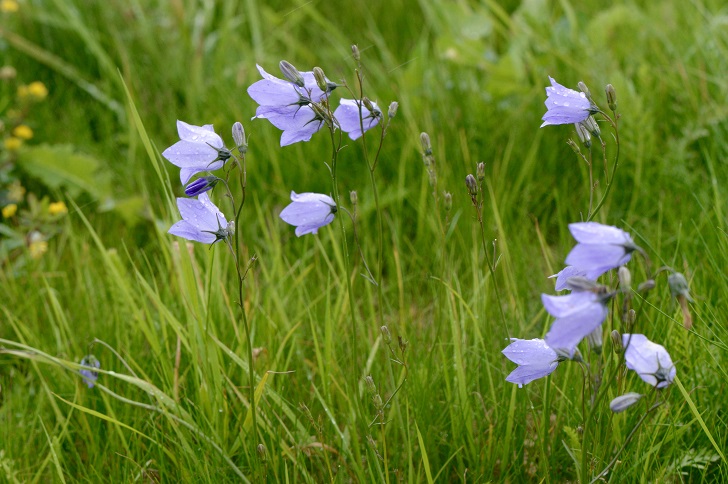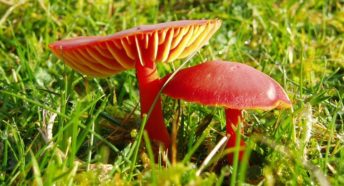A month in the countryside: connecting with nature in August
In her latest exclusive monthly column for CPRE, Susie White gives us her tips on what to look out for in nature – celebrating what makes the North Pennines so special, as well as the everyday beauty that can inspire us all.
August is a time of plenty, with nectar for insects from numerous flowers which in turn means food for birds. Young swallows fly low above the long grass of pastures and parks, scooping up flies, preparing for their autumn migration.
Blackberries are beginning to ripen in hedgerows along with wild raspberries and rose hips and there are bright red berries on the rowan. Plump green hazelnuts on the trees near my house are already being eaten by squirrels who feast on them though they’re unripe. And we are harvesting veg in our garden and storing onions and garlic for winter.
Five ways to connect with nature this August
1. Look out for harebells
Amongst the 70 species of wildflowers that I grow in my garden, are harebells, their violet-blue flowers nodding on wiry stems. They have seeded themselves in gaps between paving slabs or rise delicately out of a carpet of the late flowering Thymus ‘Redstart’.
Harebells grow in the short springy sheep-cropped turf of nearby fields, their bell-shaped flowers looking fragile but actually standing up well to the wind. Also called the bluebell in Scotland (not to be confused with the spring flowering woodland bulb) this is one of the plants of the machair of the Hebrides. They provide nectar for bumblebees and honey bees and Victorians believed that fairies slept in their bells.

2. Get ready to rock pool
A day at the coast is a chance to go rock pooling. Peering into the unruffled water reveals a different world. Though it was traditional to use a net, a bucket is far better, less likely to harm any creatures and giving a clearer view.

There are crabs of all sizes, including common hermit crabs Pagurus bernhardus, that need the shelter of shells because of their soft bodies. Each time they grow they take over a new larger home and children delight in watching a shell moving slowly through a rock pool steered by its resident crab. Lift a rock and you might find a common prawn, Palaemon serratusa, a scavenger that keeps the rock pool clean of decaying material. There may be anemones, limpets or even starfish in this submerged landscape.

3. Let jays amaze
The jays have discovered the wild raspberries that grow just outside my garden. They balance on a fence rail so that they can lean forward and snatch the red pulpy fruit with their black beaks. Seen close to, these are beautiful birds, their feathers pinky-brown with dramatic black wings, tail and moustachial stripe. It’s the patch of electric blue barred feathers that really catch my eye and I treasure one that I found on a walk.

Noisy and squabblesome, their scientific name is a suitable Garrulus glandarius. The raspberry seeds that pass through them will spread this wild food far and wide but it is their hoarding of acorns that plants trees in new areas. Like squirrels, they cache acorns in holes in the ground or in leaf litter and, although they have an incredible memory, not all will be retrieved. You can see – or more easily hear – jays in city parks as well as in the countryside.

4. Help your hedgehogs
This year it’s the 10th birthday of Hedgehog Street, a nationwide campaign launched by wildlife charities People’s Trust for Endangered Species (PTES) and the British Hedgehog Preservation Society (BHPS). My garden has been a release site for rescued hedgehogs over a number of years and they have hopefully expanded out into the wider landscape.
I’ve had some wonderful encounters with them. When I went out at night, one walked up to my shoes and sniffed them before going off unconcerned. Another spent the winter under the cover of the Stipa gigantea, the grass making the perfect thatched roof. There’s a list of ways you can help these much-loved mammals on the website hedgehogstreet.org. Especially important is linking your garden with neighbouring ones by leaving a 13cm square gap in fencing; they can roam an average distance of 2km on a single night.

5. Tempt a toad
On either side of my front door I have clusters of pots that are filled with flowers – nicotiana, cosmos, violas, lavenders and dahlias, plants that attract bees by day and moths by night. So I’m delighted when I find a large toad on the doorstep that will be on patrol for slugs during the night.
Toads have a varied diet of worms, spiders, aphids and ants. One of my most memorable sightings was when sitting in a friend’s garden at the precise moment when there was an explosion of flying ants. Two large toads were hunkered down and feasting in the middle of this insect mass, their sticky tongues repeatedly flicking out to scoop up ants with a loud snapping sound as their mouths clamped shut.

Susie White is a writer and naturalist who lives and gardens in a small valley in the North Pennines Area of Outstanding Natural Beauty. Its diverse mix of habitats and landscapes provides a rich variety of wildlife to observe and record – including through her regular Country Diary entries for The Guardian.
Read more of Susie’s observations and enjoy her great photos on twitter @cottagegardener and remember to look out for her next CPRE column in September.









